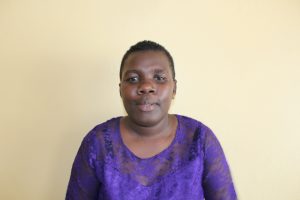Interviewees in Shihome community told us that they spend most of their income on medication. Looking at the unprotected spring from which the 175 people who live here fetch water every day, it's not difficult to find the origin of their medical woes.
Leonida Lihabi, who owns the land the spring is on (and is its namesake), worries about the children in the community. She's pictured below fetching water from the spring.

Leonida said: "[The] most affected are children, who suffer from typhoid and diarrhea because they take water from this unprotected spring without it being boiled or treated."
The spring is open to the elements and shared with local animals, who often stop here for a drink. It is also bordered by several farms whose fertilizer leeches into the water.
The community members tried to protect the spring on their own to prevent health issues and alleviate the continuous water shortages the community is facing, but it wasn't done properly. Sometimes, no water comes from the discharge pipe. Other times, particularly in the rainy season, the pipe ends up underwater. Either way, community members most often end up submerging their water containers to fill them, which stirs up sediment from the bottom of the spring and further contaminates the water.
Another way people have tried to stave off water-related illnesses is by fetching water carefully: trying not to get any dirt, algae, or leaves in their jerrycans. But, unfortunately, no matter how meticulously they fetch water, it won't work. And this slow way of fetching has also caused quarreling amongst the community members, who grow impatient waiting in long queues to fetch water when all they'd like to do is accomplish their daily tasks like cooking, cleaning, and watering their crops.

The fighting bothers 12-year-old Jemmimah (pictured above). "I feel so bad when I see our parents fighting at the spring," she said. "It's my prayer that this spring will be protected for us to have peace."
With a flowing source of reliable water, the conflict and health issues in this community should dramatically reduce, leaving them with time and energy for other things.
What We Can Do:
Spring Protection
Protecting the spring will help provide access to cleaner and safer water and reduce the time people have to spend to fetch it. Construction will keep surface runoff and other contaminants out of the water. With the community’s high involvement in the process, there should be a good sense of responsibility and ownership for the new clean water source.
Fetching water is a task predominantly carried out by women and young girls. Protecting the spring and offering training and support will, therefore, help empower the female members of the community by freeing up more of their time and energy to engage and invest in income-generating activities and their education.
Training on Health, Hygiene, COVID-19, and More
To hold trainings during the pandemic, we work closely with both community leaders and the local government to approve small groups to attend training. We ask community leaders to invite a select yet representative group of people to attend training who will then act as ambassadors to the rest of the community to share what they learn. We also communicate our expectations of physical distancing and wearing masks for all who choose to attend.
The training will focus on improved hygiene, health, and sanitation habits in this community. We will also have a dedicated session on COVID-19 symptoms, transmission routes, and prevention best practices.
With the community’s input, we will identify key leverage points where they can alter their practices at the personal, household, and community levels to affect change. This training will help to ensure participants have the knowledge they need about healthy practices and their importance to make the most of their water point as soon as water is flowing.
Our team of facilitators will use a variety of methods to train community members. Some of these methods include participatory hygiene and sanitation transformation, asset-based community development, group discussions, handouts, and demonstrations at the spring.
One of the most important issues we plan to cover is the handling, storage, and treatment of water. Having a clean water source will be extremely helpful, but it is useless if water gets contaminated by the time it is consumed. We and the community strongly believe that all of these components will work together to improve living standards here, which will help to unlock the potential for these community members to live better, healthier lives.
We will then conduct a small series of follow-up trainings before transitioning to our regularly scheduled support visits throughout the year.
Training will result in the formation of a water user committee, elected by their peers, that will oversee the operations and maintenance of the spring. The committee will enforce proper behavior around the spring and delegate tasks that will help preserve the site, such as building a fence and digging proper drainage channels. The fence will keep out destructive animals and unwanted waste, and the drainage will keep the area’s mosquito population at a minimum.

 Protected Spring
Protected Spring
 Rehabilitation Project
Rehabilitation Project

















